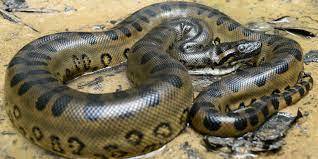The anaconda snake, renowned for its impressive size and power, is a creature that has captured the imagination of people around the world. Native to the lush rainforests of South America, these serpents possess remarkable characteristics that make them both feared and admired. Here are five captivating facts about the anaconda snake:
1. Gigantic Proportions:
Anacondas are among the largest snakes on Earth. The green anaconda (Eunectes murinus), the most famous of the anaconda species, can reach lengths of up to 30 feet and weigh as much as 550 pounds. This incredible size grants them the title of the world's heaviest snake. Their formidable appearance and ability to consume prey much larger than their heads have led to numerous myths and legends.
2. Stealthy Predators: Anacondas are apex predators, using their remarkable camouflage and stealth to hunt and ambush their prey. These snakes are non-venomous, relying on constriction to overpower their victims. Their strong coils can exert immense pressure, suffocating and immobilizing creatures like capybaras, deer, and even jaguars. Anacondas have stretchy ligaments in their jaws, enabling them to open their mouths wide and swallow their prey whole.
3. Aquatic Adaptations: Well-adapted to their semi-aquatic habitat, anacondas are exceptional swimmers. Their eyes and nostrils are positioned on the tops of their heads, allowing them to remain submerged while still observing their surroundings. This adaptation is crucial for their hunting strategy, as they can ambush unsuspecting prey from beneath the water's surface. Furthermore, their large, muscular bodies aid in both swimming and maneuvering through the dense vegetation of their habitat.
4. Mysterious Reproduction: Anacondas are known for their unique reproductive process. Female anacondas can reproduce asexually through a process called parthenogenesis, where they give birth to live young without mating. However, sexual reproduction is more common, and females can give birth to litters of up to 40 baby snakes, known as neonates. These neonates are already equipped with survival instincts and a functional set of skills, reflecting the harsh environment they are born into.
5. Cultural Significance: Anacondas have left a significant mark on various cultures and mythologies in their native South America. They are often revered and feature prominently in indigenous folklore. These serpents are considered symbols of power, transformation, and the natural world's intricate balance. Unfortunately, they have also faced threats from habitat destruction and illegal wildlife trade, prompting conservation efforts to protect their populations.
In conclusion, the anaconda snake's immense size, stealthy hunting tactics, aquatic adaptations, unique reproductive methods, and cultural significance contribute to its mystique. While often portrayed as fearsome creatures, they play a crucial role in maintaining the delicate equilibrium of their rainforest ecosystems. Understanding and conserving these magnificent reptiles is essential not only for preserving their species but also for maintaining the health of their intricate habitats.


